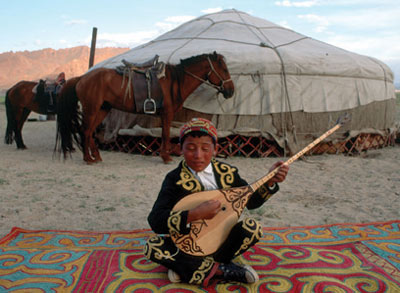
Children of Mogol
By the 14th century, the Mongol dynasty founded by the Khans started to unravel. Internal rebellions were rife, as the Yuan Mongols lost popularity among the Mongols in Mongolia, who felt the former had traded their true Mongolian identity for a Chinese one. The flooding of the Yellow River and the resulting famine in the 1340s worsened the delicate political situation. The Yuan dynasty eventually collapsed in 1368, under the rebel peasant army led by Zhu Yuan Zhang, who founded the Ming dynasty (1368-1644).
Although there are Mongolian herdsmen who continue to move with their cattle from place to place today, many have given up their nomadic lifestyle and settled down as sedentary farmers raising maize, oats, chicken and pigs since the mid-20th century. Some still live in felt-made yurts, with umbrella-shaped roofs opened at the top for ventilation. These large tents measure seven to eight feet high and ten feet across. Most have exchanged these tents for yurt-like single-storied houses made of mud and wood. Others live and work as professionals in bigger Chinese cities. On the region's roads, cross-country jeeps have replaced the horses of Genghis Khan.
Nonetheless, skills like horsemanship, archery and wrestling are still greatly appreciated, and are deeply rooted in Mongolian culture. In July and August each year, Mongolians congregate to enjoy "Nadam". Meaning "games" in Mongolian, Nadam is a traditional Mongolian fair, where the Mongols dress in their holiday best and compete in horseracing, archery, wrestling, as well as chess, dancing and singing. "Haolibao" is a popular type of Mongolian singing, where the singers improvise their own lyrics to accompany fixed melodies. To accompany their solo singing, is a horse-head fiddle - a favorite Mongolian musical instrument that produces a low, deep note.
Dialects notwithstanding, a common Mongolian language and script unite Mongols. Flowing from top to bottom, left to right, the script was adapted from Uyghur script in the thirteenth century. Mongolian scholars produced several outstanding historical and literary works, such as "The Stories of Shageder", and translations such as "The Inside History of Mongolia."
Today, local authorities in the northern Inner Mongolia Autonomous Region are hoping to boost economic growth through tourism. Places of interest include the 2,000-kilometer Great Wall ruins from the Jin dynasty, and the last capital of the Yuan dynasty. A project to expand Genghis Khan Temple is currently in action under a 220 million yuan (US$26.5 million) plan. The temple, located in the city of Ulan Hot, is the only one in the world that commemorates the life of Genghis Khan. Built in 1940, the Genghis Khan Temple features architectural styles of the Mongolian, Han and Tibetan nationalities. The temple attracts more than 200,000 tourists annually.
|

![]() 北京市通信公司提供网络带宽
北京市通信公司提供网络带宽